Adventures in Stereograms
A Cross-Eyed Story
Does it enhance my nerd credibility if I tell you that I was into stereograms before they were cool? What if I tell you that I’m still into stereograms long after they were cool? And I’ve just discovered some amazing stereograms the likes of which I’ve never seen before.
A Little Background
You remember stereograms, right? They were popular in the ‘90s under the brand “Magic Eye.” Right, they were those books and posters where you could cross or uncross your eyes just the right amount and a 3D image would pop out. Some people had trouble seeing them, and other people could see them easily.
Stereograms were invented by a neuroscientist named Christopher Tyler in 1979. But I accidentally discovered stereograms on my own as a little kid right around the same time. I used to sleep on the bottom bunk of a bed, and would stare up at the underside of the top bunk. The wood panels that supported the top mattress had a grid of holes like peg board. As I lay in bed staring up at those dots, I’d let my eyes relax. The views from my eyes would diverge, causing double vision, until the pattern of holes overlapped again. I found that I could see the pattern clearly even though my eyes were focused on a different plane, and the dots appeared to float in space between me and the top bunk. Where the holes in the board weren’t completely aligned, some dots floated closer to me than the rest. I used to reach up and try to touch them, and the illusion would break as my fingers passed through them. It was a very basic 3D stereogram.
Fast forward several years to November, 1991. I was in high school reading OMNI magazine (add that to my nerd cred), and I came across this article about a man named Dan Dyckman who developed software to make your own single image random dot stereograms. It was the first time I’d ever seen a stereogram outside my bunk bed:
I was so excited. I understood exactly what he had done. I went home and wrote a simple program that made a basic stereogram of a pyramid popping out of the page. I was thrilled.
Tied into the article, the magazine also had this ad from N. E. Thing Enterprises, future publisher of Magic Eye books, when they still referred to them as Stare-E-O’s:
A few years later, stereograms were suddenly everywhere. Magic Eye posters were in dorm rooms, shopping malls, album covers and joked about on Seinfeld and Friends. If ‘90s cafes ever become a thing (why do some decades get themed restaurants and others don’t?) you know there will be Magic Eye posters above the urinals in the men’s room.
After The Fad
Time passed. Like all fads, Magic Eye posters faded into history. But not everybody forgot about stereograms, and some enthusiasts continue to play with new ways to use them.
Some people experimented with animated stereograms. A particularly good example is this 2014 music video by a band called Young Rival for their song Black is Good.
Director Jared Raab explained how he made it:
We collected real-time depth data of Young Rival performing the song using an X-Box Kinect hooked up to a computer…. capturing the depth information from the Kinect using its built-in infrared system. Once we had our depth information, we unpacked it into image sequences and edited these sequences as if they were regular video. The only difference in the editing process was that depth was represented by luminosity.
With much trial and error, we then ran the data through an algorithm which took each frame of depth information, converted it into a random dot stereogram image, and repacked it into the final video.
Amazing.
In 2018, McSweeney’s published a quite clever collection of 15 stereograms by funny-guy Dan Caprera that I encourage you to go look at, especially if you live in Texas.
There are still artists playing with stereograms, like 3Dimka, who uses techniques that emphasize the edges of the 3D object, making the most crisp and clear stereogram images I’ve ever seen:
They even made a Stereogram Tetris game.
And of course there’s also a subreddit for stereogram fans where people share new experiments along with old favorites from the stereogram heyday. I enjoy seeing what people come up with, and new techniques for making even sharper images that pop off the page or screen.
And that’s where I discovered the stereogram work of a computer scientist named Scott Pakin based in Los Alamos.
Scott Pakin’s Stereograms
Now I’m getting to the real subject of this week’s newsletter.
If you have a long memory of internet history, you might recall Scott Pakin from his automatic complaint-letter generator that went viral in the late ‘90s and became famous enough to merit its own Wikipedia entry.
Scott has created a series of stereogram experiments exploring some very clever ideas. He has around 75 of them, and they all stem from different ideas he wanted to try, like:
Can you make a stereogram that includes lighting effects?
Could you take a photo that’s a stereogram?
Could you make a stereogram that’s also a valid QR code?
Some of his experiments work better than others. But I love this kind of exploration!
I’ve embedded a few examples here, with his notes:
Transparency
This is an experiment in including (faux) transparency in stereographic images. In Beach Ball, note how the ball has red spots in front and purple spots in back, and you can see the purple spots through the transparent red spots. I like how this image turned out.
Single Line
Is it possible to draw a single-image stereogram without taking your pen off the paper? String Theory demonstrates that it is.
Anaglyph
I was wondering if it's possible to produce an image that's simultaneously an autostereogram and an anaglyphic stereogram (to view through red-cyan glasses). Wooden Chair is my first attempt to produce such a unified stereogram. The anaglyph image looks good, but I wish that the autostereogram were crisper.
If you’re like me, you keep a collection of anaglyph 3D glasses in a pencil holder on your desk for occasions when you come across something like this. I love this one.
Combining Methods
This image represents an attempt to combine a wallpaper stereogram and a single-image stereogram. In Pottery Sale, the pottery is a wallpaper stereogram while the back wall and the front of the table are both single-image stereograms.
The One That Really Blows My Mind
All that stuff is neat and clever. But there’s one Scott Pakin stereogram in particular that really brings a smile to my face because it plays not just with depth perception, but with how our brains perceive color, and it feels more like magic than any other stereogram I’ve ever seen.
If you’re a person who can view stereograms easily, take a look at this:
Pretty cool! Here’s what Scott had to say about this one:
Observe how the colors in this image vanish when viewed as a stereogram. Pretty neat, huh? I aligned complementary colors in such a way that they cancel each other out when overlapped, and that seems to have worked exactly as intended.
I love stuff like this. I love that Scott Pakin is thinking outside the box, trying new experiments that play with our perception. And I love that this 25 year old fad still has niche practitioners pushing it further.
For A More Detailed History
AIGA has a great article that goes much further into the history of stereograms, how they went from Christopher Tylor in 1976 to being unavoidable twenty years later, and why we might never have had the Magic Eye phenomenon if not for a mime. You read that right.
And that brings us to the end of another newsletter! If you made it this far and you were frustrated by the stereograms because you’re not a person who can easily see them, here’s where you can draft your complaint, and I hope to see you here next week.
Thanks for reading!
David




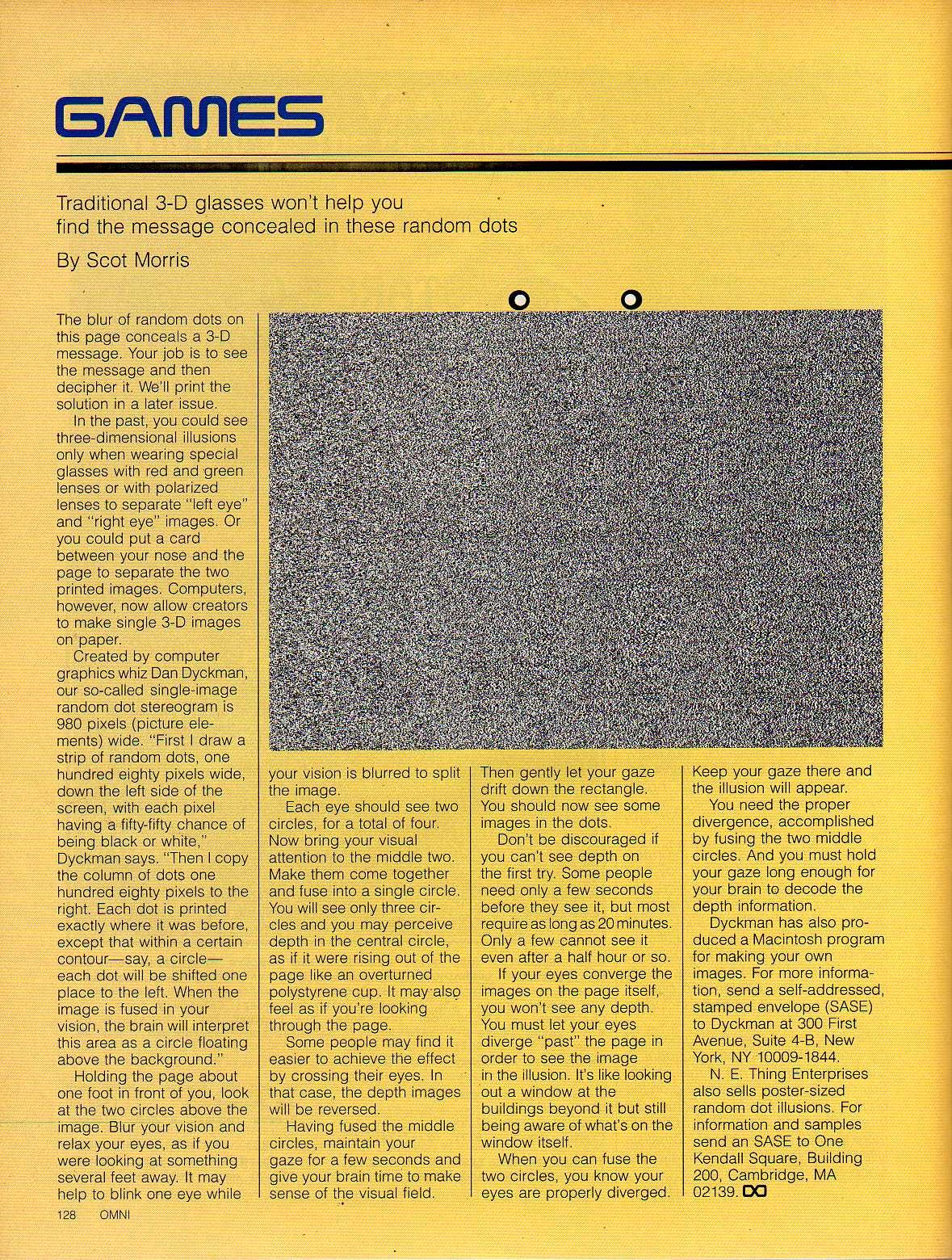


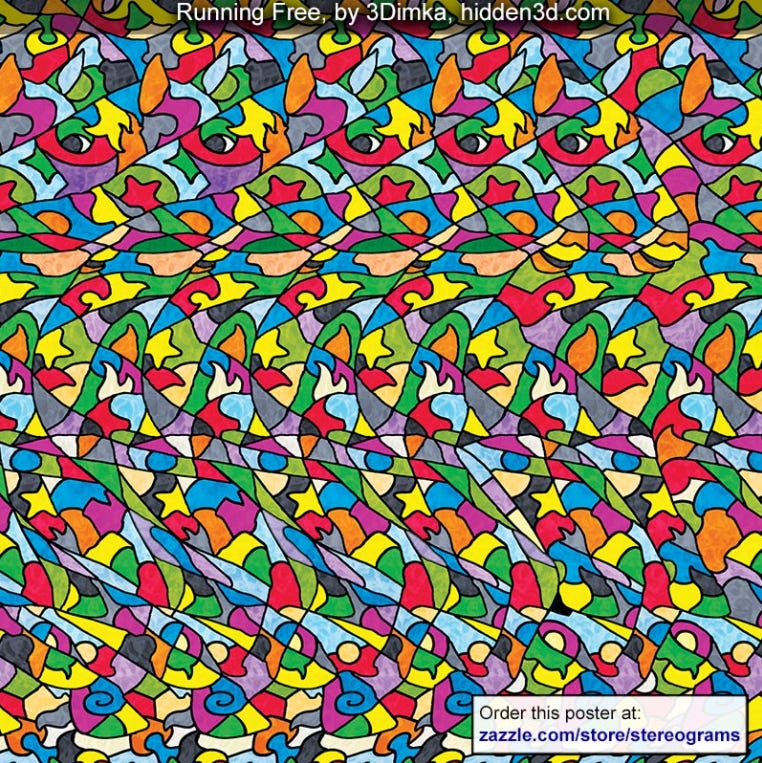

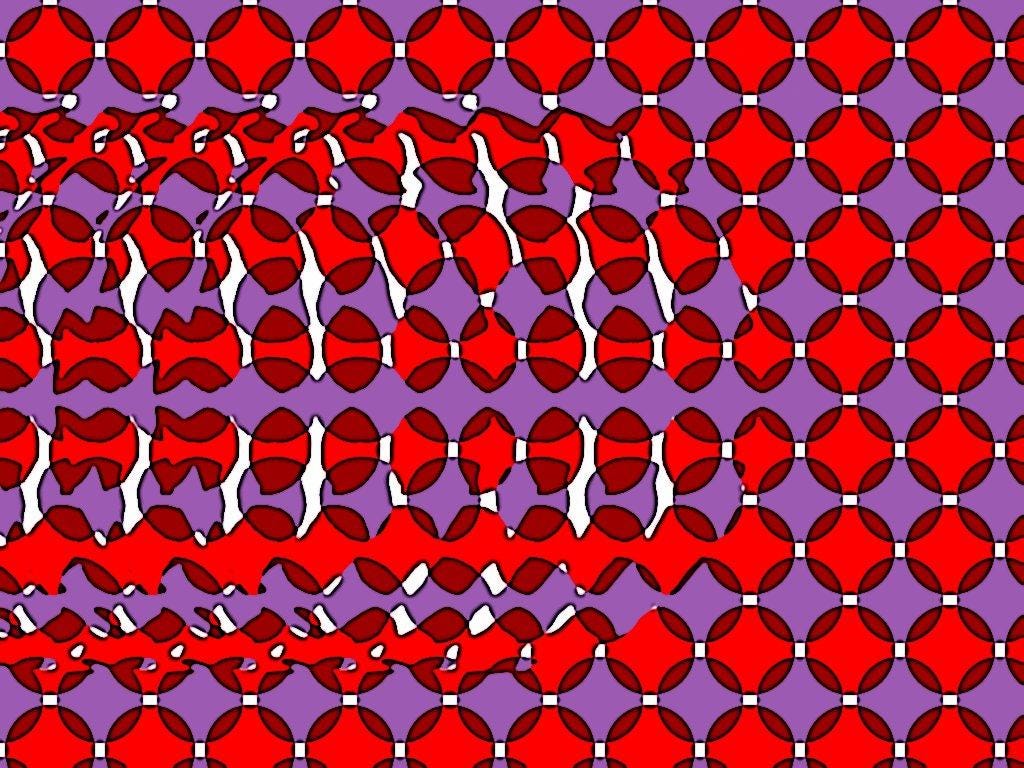
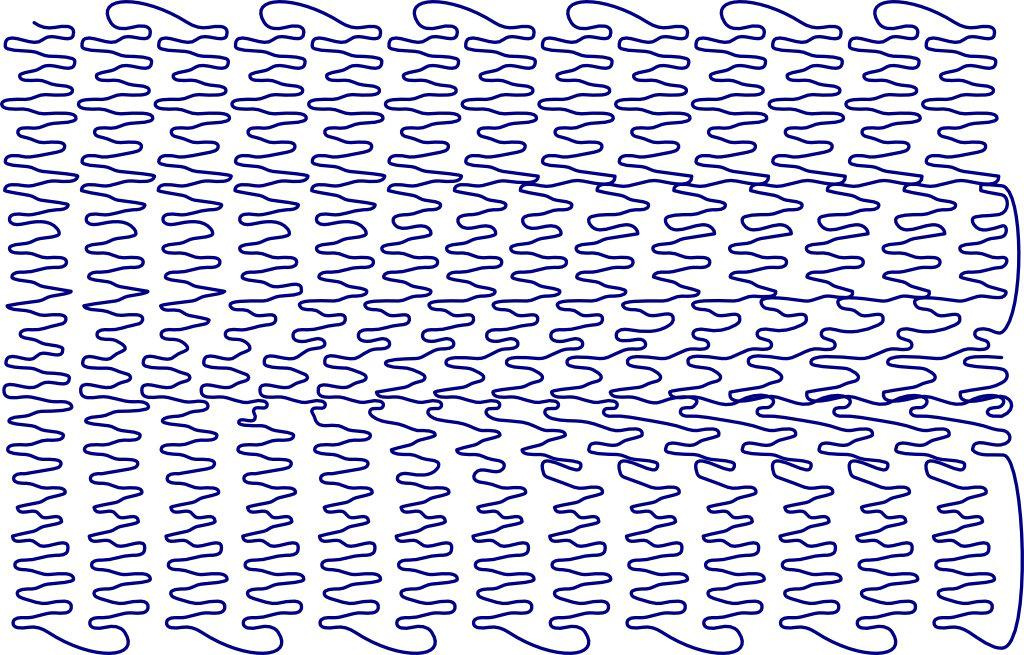

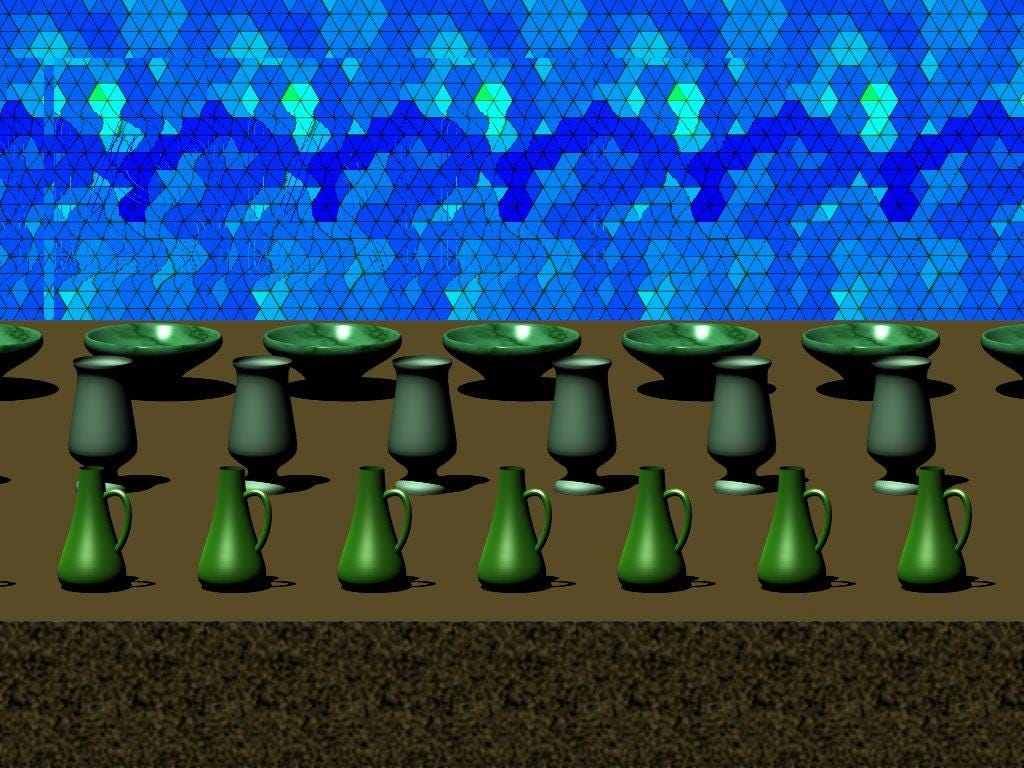



I love this stuff, thanks for this article, the musical sheet blew me away! Have you seen these ultra-deep stereograms? There aren't many of those and I'm not sure how it works, but hey, it's pretty cool, look at this: https://www.reddit.com/r/MagicEye/comments/p67996/deep_space_combination_hidden_image_object_array/
Hello,
In case you weren't aware of it, the DOS game 'Magic Carpet' from 1994 had a stereograph mode. It was great and unlike anything I've seen before or since. I remember playing it with tears pouring down my cheeks from concentrating so hard on seeing what was going on. Here's a picture.
https://mobile.twitter.com/dosnostalgic/status/732994865408188420